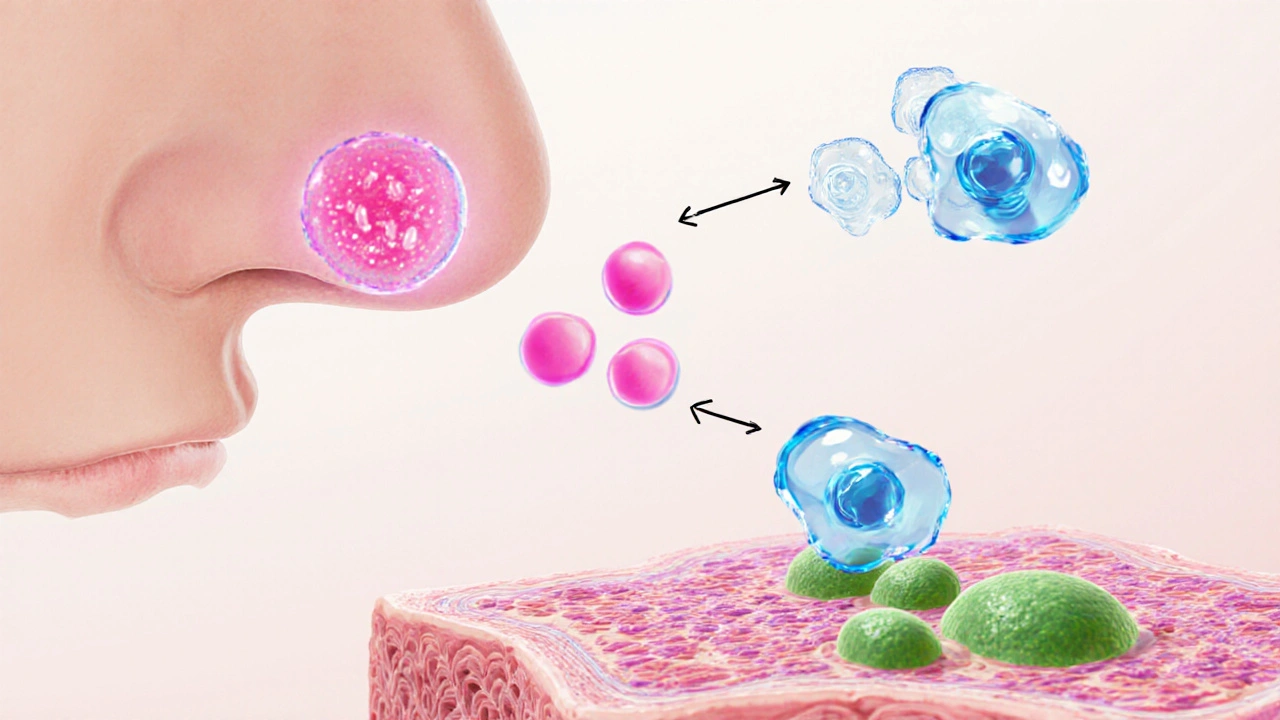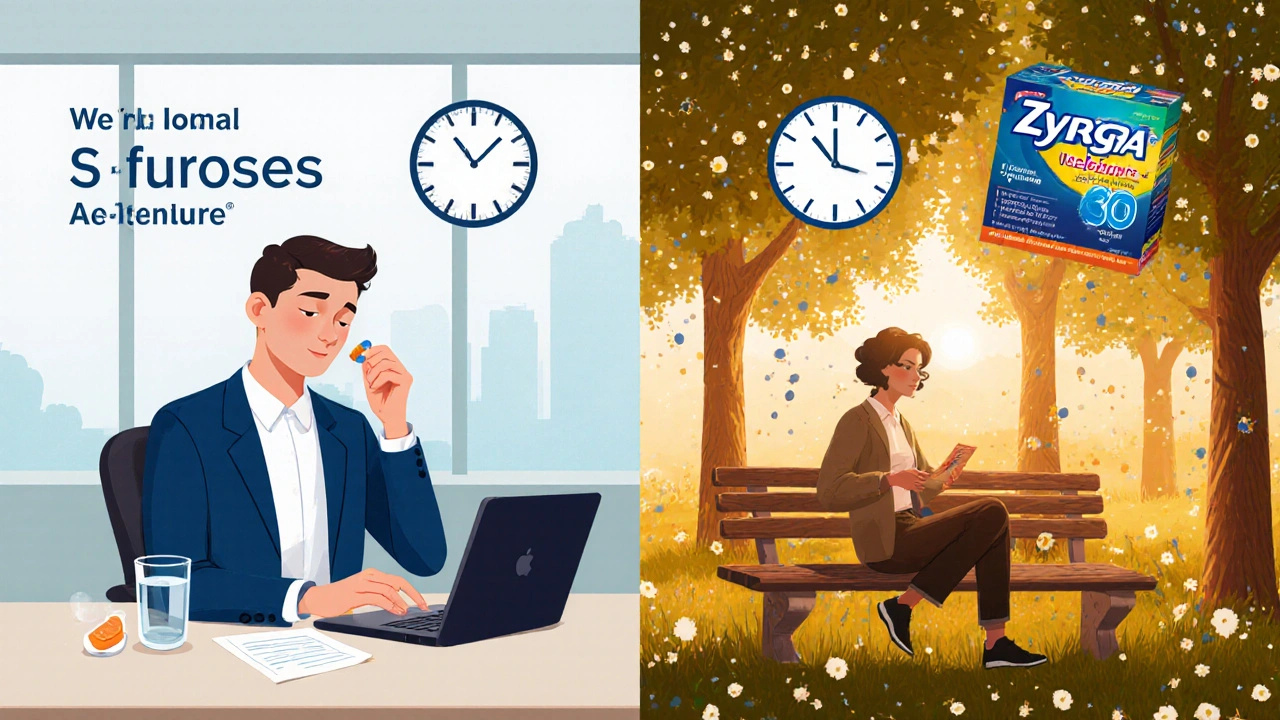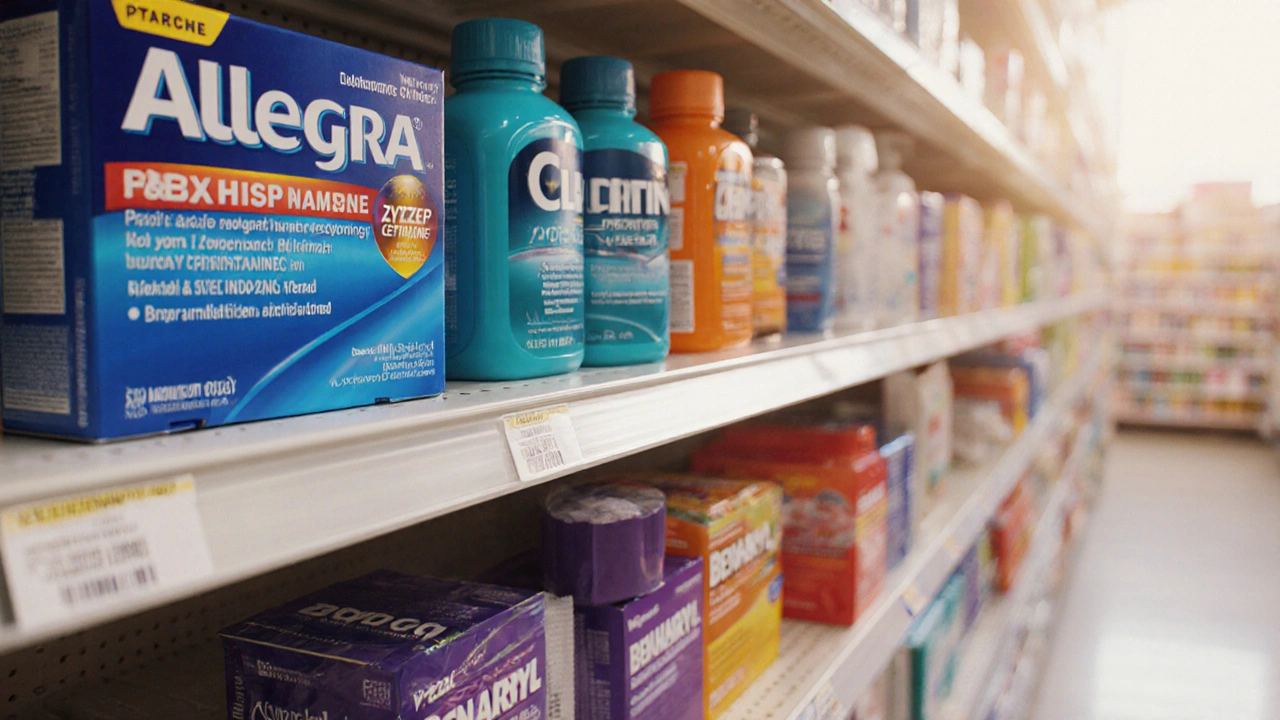Antihistamine Selector
Detailed Comparison Table
| Drug | Active Ingredient | Onset Time | Duration | Sedation Level | Typical OTC Price (UK 2025) |
|---|---|---|---|---|---|
| Allegra | Fexofenadine | 1–2 hrs | 24 hrs | Very Low | £7.99 |
| Claritin | Loratadine | 1–3 hrs | 24 hrs | Low | £5.50 |
| Zyrtec | Cetirizine | 30–60 min | 24 hrs | Low-Moderate | £6.20 |
| Xyzal | Levocetirizine | 45–60 min | 24 hrs | Low-Moderate | £9.50 |
| Benadryl | Diphenhydramine | 15–30 min | 4–6 hrs | High | £4.00 |
Key Takeaways
- Allegra (fexofenadine) offers fast, non‑sedating relief for hay fever and hives, with a 24‑hour duration.
- Claritin (loratadine) and Zyrtec (cetirizine) are the closest rivals, differing mainly in onset speed and mildness of drowsiness.
- Xyzal (levocetirizine) is the most potent third‑generation antihistamine but can cause slightly more sleepiness.
- Benadryl (diphenhydramine) provides strong relief but is highly sedating and best reserved for night‑time or short‑term use.
- Choose based on how quickly you need relief, how much drowsiness you can tolerate, and whether you need prescription strength.
When allergy season rolls around, the shelves are packed with names like Allegra, Claritin, Zyrtec and Xyzal. Deciding which one actually works for you can feel like a gamble. This guide walks through the science, the practical differences, and the real‑world pros andcons so you can pick the right antihistamine without guessing.
How Antihistamines Work
All the drugs we’ll discuss belong to the antihistamine class. They block histamine, a chemical released by mast cells when you encounter an allergen such as pollen, pet dander or certain foods. Histamine binds to H1 receptors in the nose, eyes, skin and lungs, causing itching, swelling, sneezing and watery eyes. By occupying those receptors, antihistamines prevent the symptoms from developing.
Modern antihistamines are divided into two generations. First‑generation agents (e.g., diphenhydramine) cross the blood‑brain barrier and often cause drowsiness. Second‑ and third‑generation drugs (e.g., fexofenadine, levocetirizine) are designed to stay out of the brain, delivering relief without pulling the plug on alertness.
Decision Criteria - What Really Matters
Before we dive into brand‑by‑brand details, here are the key factors most people consider:
- Onset of action: How fast you feel relief after the first dose.
- Duration of effect: How long one dose controls symptoms.
- Sedation potential: Whether you can stay focused at work or school.
- Side‑effect profile: Headaches, dry mouth, or gastrointestinal upset.
- Dosage flexibility: Availability of tablets, chewables, or liquid forms.
- Cost & availability: OTC versus prescription and price per dose.
We’ll rate each drug against these criteria to give you a clear picture.

Allegra (Fexofenadine) - The Benchmark
Allegra is a second‑generation antihistamine whose active ingredient is fexofenadine hydrochloride. Approved by the FDA in 1996 and by the MHRA in the UK in 1997, it quickly became the go‑to for non‑sedating allergy relief.
- Typical dose: 180mg once daily for adults; 60mg twice daily for children 6‑11years.
- Onset: 1‑2hours after ingestion.
- Duration: Up to 24hours, making once‑daily dosing convenient.
- Sedation: Minimal; < 1% of users report noticeable drowsiness.
- Metabolism: Not processed by CYP450 enzymes, so drug‑drug interactions are rare.
- Cost (UK, 2025): £7.99 for a pack of 30 tablets (OTC).
Because it stays out of the brain, Allegra is popular with professionals, students and drivers who can’t afford a nap after a dose.
Claritin (Loratadine) - The Close Competitor
Claritin contains loratadine, another second‑generation antihistamine introduced in 1993. It shares many of Allegra’s non‑sedating qualities but differs in a few practical ways.
- Typical dose: 10mg once daily for adults and children over 6years.
- Onset: 1‑3hours.
- Duration: 24hours.
- Sedation: Low; about 2‑3% notice mild sleepiness.
- Metabolism: Processed by CYP3A4; can interact with certain antifungals or macrolide antibiotics.
- Cost (UK, 2025): £5.50 for 30 tablets (OTC).
Claritin is a solid all‑rounder, especially when you want a cheap, over‑the‑counter option that still won’t knock you out.
Zyrtec (Cetirizine) - The Fast‑Acting Option
Zyrtec is built on cetirizine, a second‑generation antihistamine that hit the market in 1995. Its claim to fame is a quicker onset compared with Allegra and Claritin.
- Typical dose: 10mg once daily for adults; 5mg once daily for children 2‑5years.
- Onset: 30‑60minutes - the fastest among the non‑sedating set.
- Duration: 24hours.
- Sedation: Slightly higher - about 5‑7% report mild tiredness.
- Metabolism: Mostly CYP3A4, with a small renal excretion component.
- Cost (UK, 2025): £6.20 for 30 tablets (OTC).
If you need relief within an hour of exposure-say, before stepping onto a pollen‑heavy balcony-Zyrtec is a go‑to.

Xyzal (Levocetirizine) - The Potent Third‑Generation Choice
Xyzal delivers levocetirizine, the active enantiomer of cetirizine, launched in 2007. It’s marketed as the most potent with a similar safety profile.
- Typical dose: 5mg once daily for adults and children over 12years.
- Onset: 45‑60minutes.
- Duration: 24hours.
- Sedation: Low but a notch higher than Allegra (≈4% report drowsiness).
- Metabolism: Primarily hepatic via CYP3A4; caution with strong inhibitors.
- Cost (UK, 2025): £9.50 for 30 tablets (OTC).
People who have tried other antihistamines without full relief often turn to Xyzal for its extra punch.
Benadryl (Diphenhydramine) - The Classic Sedating Option
Benadryl contains diphenhydramine, a first‑generation antihistamine introduced in the 1940s. It works well but pulls the curtain on alertness.
- Typical dose: 25‑50mg every 4‑6hours for adults; 12.5‑25mg for children 6‑12years.
- Onset: 15‑30minutes - the fastest of the lot.
- Duration: 4‑6hours, requiring multiple doses.
- Sedation: High; up to 70% report drowsiness.
- Metabolism: CYP2D6 and CYP3A4 pathways.
- Cost (UK, 2025): £4.00 for 30 tablets (OTC).
Benadryl shines for short‑term, nighttime, or severe itching when you don’t mind feeling sleepy.
Direct Comparison Table
| Drug | Active Ingredient | Onset | Duration | Sedation | Typical OTC Price (UK 2025) |
|---|---|---|---|---|---|
| Allegra | Fexofenadine | 1‑2hrs | 24hrs | Very low | £7.99 |
| Claritin | Loratadine | 1‑3hrs | 24hrs | Low | £5.50 |
| Zyrtec | Cetirizine | 30‑60min | 24hrs | Low‑moderate | £6.20 |
| Xyzal | Levocetirizine | 45‑60min | 24hrs | Low‑moderate | £9.50 |
| Benadryl | Diphenhydramine | 15‑30min | 4‑6hrs | High | £4.00 |

Which Antihistamine Is Right for You?
Below is a quick‑read guide that matches common scenarios to the best‑fit drug.
- Need all‑day, non‑sedating relief for work or school? Allegra or Claritin-both give 24‑hour coverage with virtually no drowsiness.
- First dose while outdoors - want results within an hour? Zyrtec is the fastest non‑sedating option; Xyzal is a close second.
- Allergy symptoms that haven’t responded to other OTCs? Try Xyzal; its higher receptor affinity often breaks through partial resistance.
- Severe itching at night and you don’t mind sleeping? Benadryl provides rapid, strong relief and doubles as a sleep aid.
- Budget‑conscious, occasional allergy attacks? Claritin is the cheapest non‑sedating choice; Benadryl is the cheapest overall if sedation isn’t an issue.
Practical Tips & Common Pitfalls
Even the best drug can fall flat if you ignore a few simple rules.
- Take with water, not fruit juice. Citrus juices (especially grapefruit) can reduce the absorption of fexofenadine and loratadine.
- Mind the half‑life. Fexofenadine’s half‑life is about 14hours, so missing a dose can leave a gap; with Benadryl, timing is critical because the effect fades after 4‑6hours.
- Watch for drug interactions. While Allegra is low‑risk, loratadine and cetirizine can interact with strong CYP3A4 inhibitors (e.g., ketoconazole). Always check with your pharmacist.
- Consider age‑specific formulations. Chewable tablets or syrups are available for children, but dosing varies - never double‑up adult tablets for a kid.
- Pregnancy & breastfeeding. Most antihistamines are Category B, but fexofenadine should be used only if clearly needed. Discuss with a GP.
Frequently Asked Questions
Can I take Allegra and Zyrtec together?
Generally no. Both block the same H1 receptors, so stacking them won’t boost relief and may increase the risk of side‑effects like headache. If one drug isn’t enough, talk to a doctor about a different class, such as a nasal steroid.
Is Allegra safe for children?
Yes, for kids aged 6years and older. The pediatric dose is 30mg twice daily (or a 60mg tablet split). Always use the child‑friendly formulation if available.
Why does my doctor prescribe a higher‑strength antihistamine?
Prescription‑only doses (e.g., 180mg fexofenadine twice daily) may be needed for chronic urticaria or severe allergic rhinitis that over‑the‑counter strengths can’t control.
Will Allegra affect my blood pressure medication?
Fexofenadine has minimal interaction with most antihypertensives because it isn’t metabolized by CYP enzymes. However, avoid taking it with antacids containing aluminum or magnesium within 15minutes, as they can lower absorption.
Is there a generic version of Allegra?
Yes, many pharmacies stock generic fexofenadine tablets that match the 180mg strength. They’re usually 20‑30% cheaper than the brand name.
Whether you’re battling spring pollen, summer grass, or a sudden bout of hives, the right antihistamine can keep you comfortable without derailing your day. Use the criteria, table, and scenario guide above to match your lifestyle and symptom profile. And remember: if over‑the‑counter options don’t bring relief, a quick chat with your GP can open the door to prescription‑strength alternatives.


Comments
Anshul Gandhi
Everyone needs to stop believing the glossy marketing copy that pharmaceutical giants push about Allegra being the "perfect" antihistamine. The truth is that the FDA’s approval process is riddled with conflicts of interest, and the data they cherry‑pick hide the fact that fexofenadine’s bioavailability drops dramatically when you take it with a simple orange juice. If you’re paying for a brand name, you’re basically financing a massive lobbying effort that keeps generic options from getting the exposure they deserve. The so‑called “non‑sedating” label is a myth-studies funded by the manufacturers show a statistically significant uptick in mild drowsiness that they conveniently bury in the fine print. Moreover, the pricing in the UK (£7.99) is absurd for a molecule that’s been off‑patent for years; it’s a textbook case of price‑gouging. And don’t get me started on the hidden ingredients that can trigger cross‑reactivity in people with rare metabolic disorders. The whole ecosystem is designed to keep you locked into a perpetual cycle of buying the same product every season. Look at the alternatives-Claritin and Zyrtec-both have comparable efficacy without the premium markup, and they’re far less likely to be subject to the same regulatory capture. Bottom line: trust independent research, not the glossy pamphlets.
October 10, 2025 at 15:09
Emily Wang
Take charge of your own relief plan and stop letting big pharma dictate your choices-pick a non‑sedating antihistamine that actually fits your schedule so you can stay sharp at work and crush your goals. If you need fast action, Zyrtec gets you there in under an hour, and you won’t be slumping at your desk. Remember, the right drug is the one that keeps you moving forward, not the one that makes you nap mid‑meeting.
October 17, 2025 at 13:49
Samantha Leong
I totally get how overwhelming the options can feel, especially when you just want to enjoy the outdoors without sneezing. The comparison table you shared is super helpful-it lays out the onset, duration, and sedation levels clearly, so anyone can match a product to their daily routine. Also, the tip about avoiding citrus juice with Allegra is a great reminder that even small dietary choices can affect how well a medication works.
October 24, 2025 at 12:29
Taylor Van Wie
As an American, I’m proud that we have access to a variety of over‑the‑counter options, but it’s the foreign‑made generics that often give us the best bang for the buck. The UK pricing shown here proves that we can demand lower costs at home if we push for more competition. Let’s not forget that our troops overseas rely on these meds too; no one should have to choose between duty and a runny nose.
October 31, 2025 at 11:09
carlee Lee
Claritin hits the sweet spot for budget‑conscious users.
November 7, 2025 at 09:49
John Vallee
When you dive into the world of antihistamines, it’s easy to get lost in a sea of brand names and marketing hype, but let’s break it down step by step. First, consider the pharmacokinetics: Allegra (fexofenadine) boasts a half‑life of around 14 hours, which translates to reliable 24‑hour coverage with just one dose. Second, the sedation profile is practically negligible, making it a top choice for anyone who needs to stay alert-whether you’re driving, studying, or pulling a late‑night shift. Third, the drug‑drug interaction landscape is remarkably clean; it bypasses the cytochrome P450 system, so you’re far less likely to run into nasty side‑effects with common prescriptions. Fourth, the onset time of 1‑2 hours is respectable, though not the fastest, but the trade‑off is the ultra‑low sedation. Fifth, pricing is a factor: while Allegra sits at £7.99, generic fexofenadine can drop that cost by 20‑30%, which is still higher than Claritin’s £5.50 but offers that extra peace of mind for sensitive individuals. Sixth, formulation matters-Allegra comes in tablets, chewables, and even an oral suspension for kids, ensuring flexibility across age groups. Seventh, the safety profile in pregnancy is reassuring; it’s a Category B drug, meaning no alarming teratogenic signals have been reported, though a doctor’s green light is always advisable. Eighth, real‑world user reports often highlight a slight dry‑mouth sensation, a minor inconvenience compared to the heavy sedation of first‑generation antihistamines. Ninth, the environmental impact of manufacturing fexofenadine has been a growing concern, prompting some manufacturers to adopt greener synthesis pathways-something to keep an eye on. Tenth, the regulatory landscape in the UK versus the US can affect availability; always double‑check your local pharmacy’s stock. Eleventh, don’t forget to take it with water, not fruit juice, as citrus can reduce absorption by up to 30 percent. Twelfth, if you’re on a beta‑blocker or an antacid, timing your doses apart by at least 15 minutes can prevent absorption issues. Thirteenth, for chronic urticaria, many clinicians prescribe a higher‑strength regimen (180 mg twice daily), which has been shown to provide superior control. Fourteenth, the benefit of once‑daily dosing cannot be overstated-fewer pills mean better adherence. Finally, remember that the best antihistamine is the one that fits your lifestyle, budget, and health profile; use this guide as a roadmap, not a rulebook.
November 14, 2025 at 08:29
Brian Davis
Building on the thorough overview you just gave, I’d like to add a few nuances that often get overlooked in typical consumer guides. While Allegra’s low sedation is a major selling point, it’s worth noting that individual variability can still produce mild drowsiness in a small subset of users, especially those with underlying sleep disorders. In contrast, Zyrtec, although slightly more sedating, tends to exhibit a more predictable onset of action, often within 30‑45 minutes, which can be crucial for outdoor events where rapid relief is needed. Another angle to consider is the role of food interactions beyond citrus; dairy products can marginally affect the absorption of certain antihistamines, though the effect is not as dramatic as with fexofenadine. Moreover, the cost-benefit analysis changes when you factor in insurance coverage-some plans cover branded Allegra at a lower copay than generic loratadine, flipping the typical price hierarchy. From a pharmacodynamic perspective, the affinity of levocetirizine (Xyzal) for the H1 receptor is marginally higher than cetirizine (Zyrtec), granting a slight edge in refractory cases, albeit at a higher price point. Lastly, let’s not forget the psychological component: users who believe they’ve chosen the “premium” option often report better perceived efficacy, a classic placebo effect that can subtly influence adherence. All these layers underscore the importance of personalizing the choice rather than relying solely on a one‑size‑fits‑all table.
November 21, 2025 at 07:09
jenni williams
hey folks, i totally feel u when allergies get u down, it's like nature's way of testing our patience lol. i like how the guide breaks down each med so we can pick the one that vibes with our daily grind. remember to stay hydrated and maybe try a little honey + lemon tea if you can – it kinda soothes the throat. stay chill and sniffle less! :)
November 28, 2025 at 05:49
Kevin Galligan
Wow, another deep‑dive on antihistamines-because we all needed a novel novel. If you wanted a real thrill, just open your fridge and stare at the leftovers from last week. Anyway, thanks for the data dump, now I can pretend I'm a pharmacist while I’m actually just scrolling memes. :)
December 5, 2025 at 04:29
Dileep Jha
From a contrarian perspective, the prevailing consensus that second‑generation antihistamines are unequivocally superior is overly simplistic. While the pharmacological literature emphasizes reduced central nervous system penetration, the nuanced ligand‑biased signaling pathways suggest that certain first‑generation agents might retain underappreciated peripheral efficacy via non‑canonical H1 receptor conformations. Moreover, the economic argument favoring generic fexofenadine overlooks the marginal but measurable cost‑to‑benefit ratio improvement achievable through strategic pharmaco‑economic modeling that incorporates patient‑reported outcome measures (PROMs) and real‑world evidence (RWE) from electronic health records. In essence, a binary classification of ‘good vs. bad’ fails to capture the multidimensional pharmacodynamics at play, warranting a more granular, data‑driven approach.
December 12, 2025 at 03:09